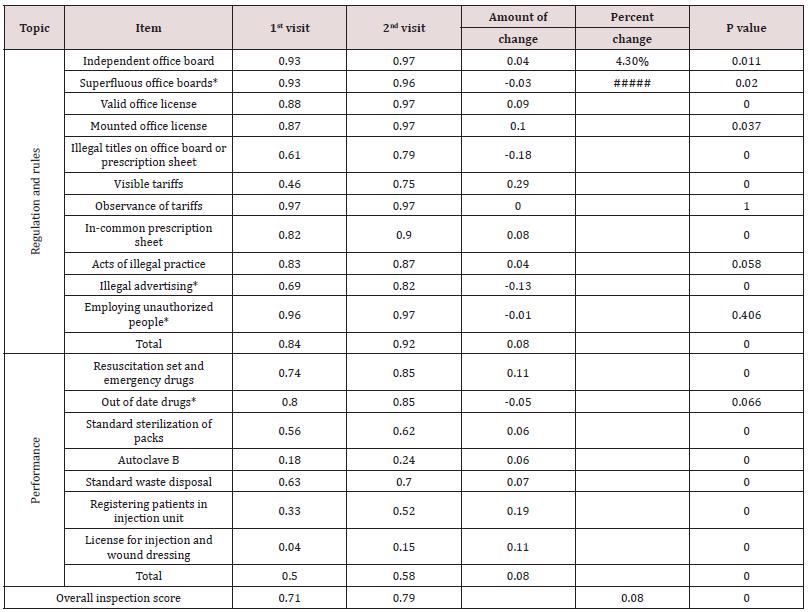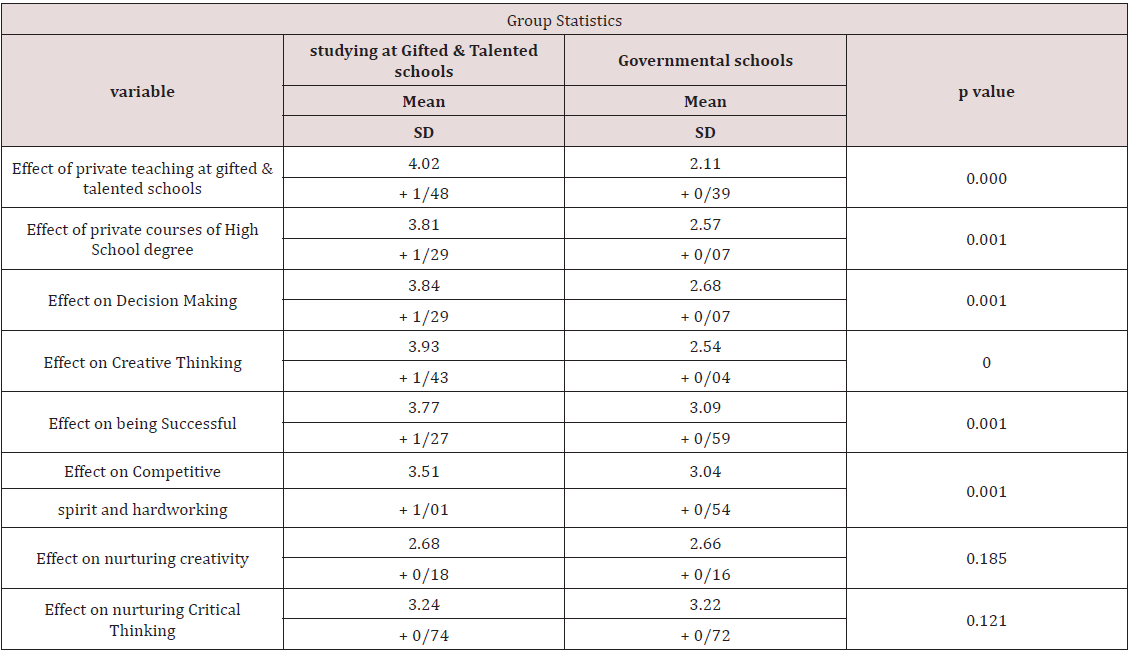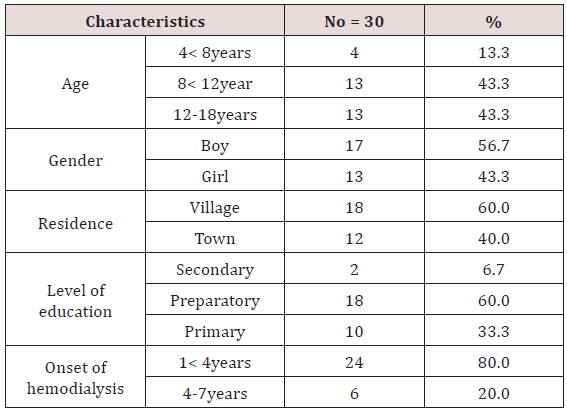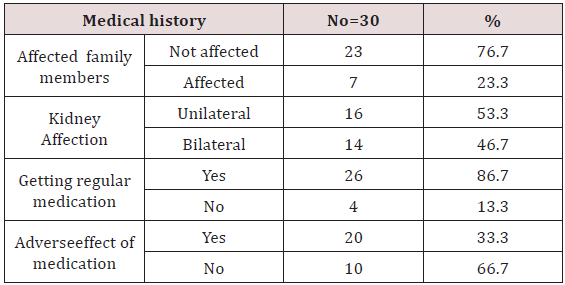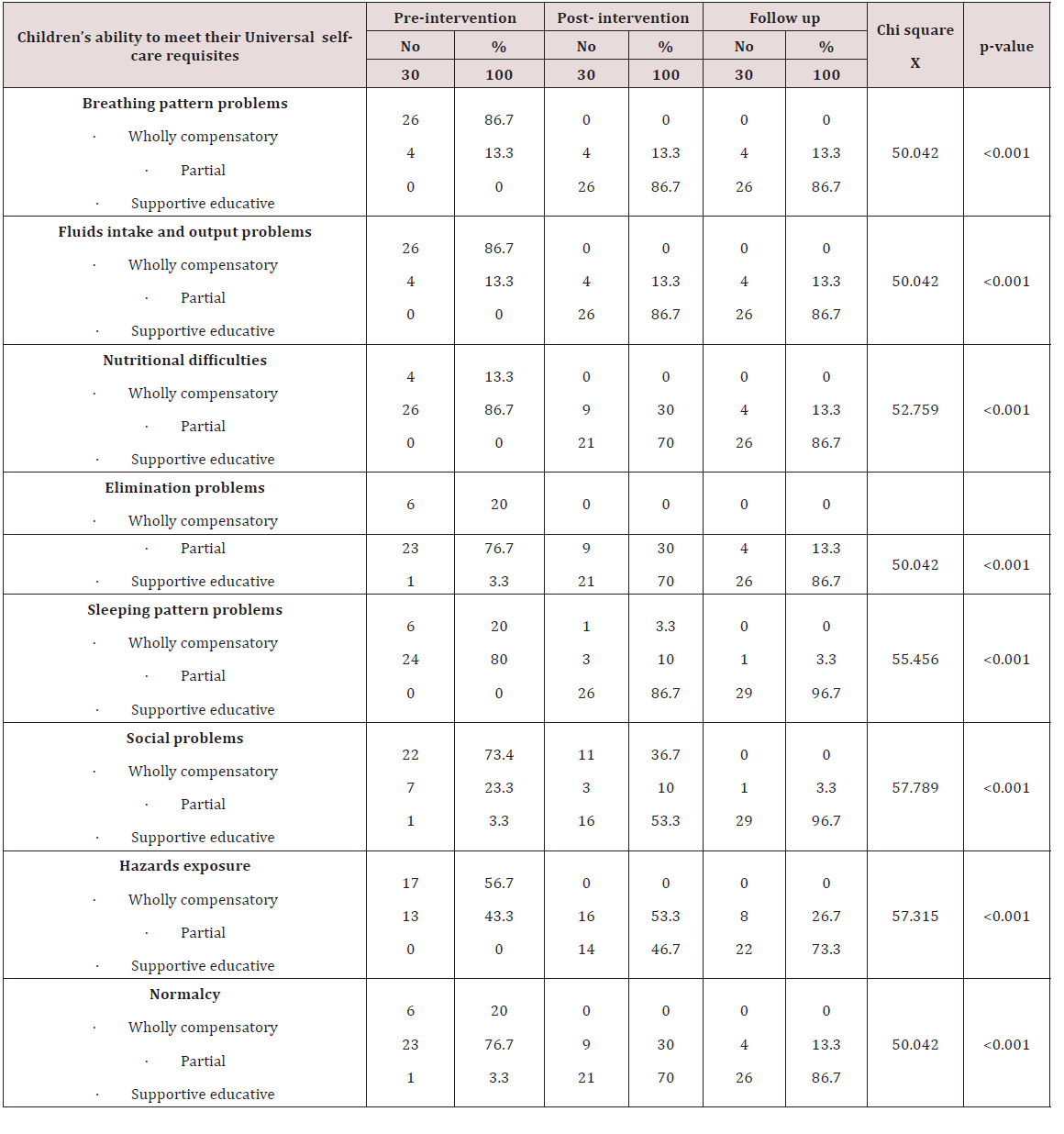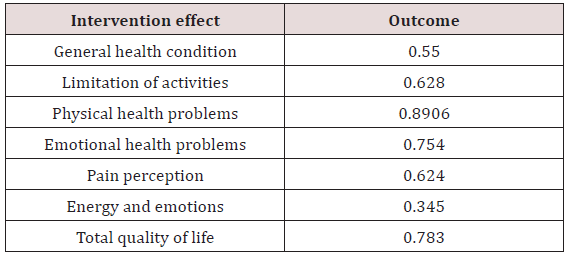Lupine Publishers | Journal of Health Research and Reviews
Abstract
Introduction: One of the mainstays for maintenance of standards of health care in medical facilities and offices is to have a constant supervision over their processes and products. We designed a study to evaluate the effectiveness of regular inspecting visits of private physician offices.
Methods: A “study checklist” consisting of 11 items under the topic of regulations and rules, and 7 items under the topic of performance, was designed, validated and used in the inspections. Results of two consecutive inspections were recorded and compared.
Instructions regarding defects in provided services were given to the doctors during inspections, and various feedbacks as dictated by present regulations were provided to them.
Results: participants were 300 general practitioners office. After the first round of inspections of all the offices, the feedback consisted of: oral warning to the doctor about noticed failures or notice about the substandard practice in the inspection records of the doctor in 32.3% of cases, warning letter of defects in 46.3%, and summoning the doctor for a written statement in 21.3%. Mean scores after gathering and computing scores of each office in first and second rounds of inspections in rules and performance topics were respectively 84, 92, 50, and 58. Among all items, installing tariffs exposed to customers’ view had the highest improvement in score.
Conclusion: Our work demonstrates that regular inspector visits of private doctor offices is an effective method for supervision on these centers.
Keywords: Supervision; Inspection; Checklist; Quality of care; Physician office; Accreditation
Introduction
One of the main pillars for maintenance or promotion of functional standards while operating a structure which delivers services to customers, is to have a steady observation over the activities of the subordinate system and the outcomes. When services are focused on health and medical concerns, effective supervision has to see whether the standards of care are reflected in the processes and products of the organization. In Iran, healthcare services and medical education have been integrated under the Ministry of Health and Medical Education; and every university of medical sciences, besides its teaching role for students of all medical fields, has to manage the distribution and quality of health services supplied in a defined geographical area. As in other universities, the Vice Chancellorship for clinical administration (VCCA) of Tehran University of medical sciences (TUMS) ensures the responsibility of administering high-quality medical services in its supervised region. In order to follow this duty, a consistent program for inspecting any establishment that provides medical services has been settled in the VCCA of TUMS (VCCAT). Since human workforce and public budget is being used for executing supervision and inspection plans, and because this program aims to prevent substandard illicit, or illegal work, as well as improve quality of care and reach the excellence in the area, the efficacy of the program had to be assessed. Doctors’ private offices are among the centers that are checked at defined intervals in this program. We designed a study to evaluate the outcome of these inspections.
Materials and Methods
As per de present program in the VCCAT, inspector visits of the doctors’ offices take place biannually, and several items are evaluated through a standardized checklist. Normally, at the time of inspection, instructions about defects in standard service and needed improvements are given to the doctor or other staff in the office, while results of the visit are presented to the relevant directors in the VCCAT, where appropriate reaction plans are taken, based on circumstances of the office and the country law. These might consist of oral advice to the doctor about noticed failures, notice about the substandard practice in the inspection records of the doctor in the VCCAT, feedback letter mentioning defects seen during the inspection and warning about rapid corrections, or calling up the doctor to the VCCAT for a written statement about the flaws. In some distinct conditions, the doctor is referred to judicial authorities. In this cross-sectional study, we planned to measure the outcome of these inspections and interventions on general practitioners working in private offices. Assuming an increase in total index of about 49%, the error value and type 1 error of 5%, the total sample size by Cochran formula (for limited population) was 278 private offices; and 300 offices were entered in the study in order to compensate for the possible loss of data due to exclusion of some offices during the study. Random stratified sampling was used for entering the offices in the study. Criteria for offices of general practitioners to be included in the study consisted of practice of less than 15 years in the office by the same doctor, and comprising an injection and wound dressing unit. Exclusion criteria included offices who had a long documented reputation of very qualified work, and those with a history of precedent violation of office rules with referral to judicial authorities.
In order to compare the results of 2 consecutive visits, we prepared a semi-structured “study checklist” (Figure 1) out of the standard “present checklist”- that is, the checklist that was used in routine inspections before the study- with closed questions, the former included the most important and measurable indicators out of the latter, as well as general characteristics of the office. Validity of the study checklist was checked by content validity: The present checklist was assessed by 40 acknowledged inspectors, expert nurses and medical doctors of the VCCAT and 18 items of the checklist were approved for the study checklist. These consisted of 11 items under the topic of regulations and rules, and 7 items under the topic of performance. Regarding the yes/no questions in the study checklist, a score of 0 or 1 was given to each entry. On the other side, each indicator was assigned a weight from 1 to 100 according to the degree of importance of the issue.
The interval between the first and second visits was 6 months for each office. Inspections were performed by expert inspectors of the VCCAT and study checklists were completed by them. Scores of all visits were calculated regarding grades and weights of questions, then scores of each item and each topic as well as the final score of consecutive inspections for each office were compared. Results were analyzed via SPSS version 9. Baseline characteristics were presented as medians, means and standard deviation for quantitative variables and percentages/counts for discrete parameters, and T-test was used for analytical statistics. P-value <0.05 was considered significant.
Results
In this study, participants consisted of 300 offices from general practitioners. From these, 138 (46%) worked in individual offices, and 62 (54%) were in doctor office complexes (buildings dedicated to doctors’ offices, comprising between 3 to any number of offices). As for the sex distribution, 80% of doctors in the included offices of the geographical area were men, and 20% were women. After the first round of inspections of all the offices, the feedback of the VCCAT consisted of: oral warning to the doctor about noticed failures or notice about the substandard practice in the inspection records of the doctor in 32.3% of cases, warning letter of defects in 46.3%, and summoning the doctor for a written statement in 21.3%. Mean scores after gathering and computing scores of each office in first and second rounds of inspections in rules and performance topics are demonstrated in Table 1.
Discussion
In the present study, the effectiveness of inspections of private offices of general practitioners carried out by inspectors of the VCCAT in 2016, was assessed. The comparison of the mean scores of two consecutive visits performed at 6 months interval showed an increase of 11.6% , which was significant (p=0.000). In the topic of regulations and laws, there was a 9.5% increase in the score of the second round of visits. Among these, installing tariffs exposed to customers’ view was one the most poorly observed items, but had the highest improvement in score (63%). As well, there was a good improvement in omitting previous illegal titles on office boards or prescription sheets (29.5%), and illegal advertising (18.8%). The least improvements were seen in independent office board (4.3%), superfluous office boards (3.2%), employing unauthorized people (1%), and observance of tariffs (0%). In the latter item, the rate was already high at the beginning of our research. This is because the Ministry of Health had passed new laws for rates of tariffs, penalties for adherence to these rates, and methods of monitoring them by inspectors about 1.5 years previous to this study. As a result, loads of effort had been exerted in that time and a good control had been obtained previously. However, detection of unapproved or unlicensed individuals working in offices is a hard job because the inspections are performed once per semester whereas these workforces may be hired for part-time work; and this is the same for undertaking illegal acts because they are not practiced permanently. On the other hand, set of existing rules are not as powerful as to prohibit these latter banned acts. As to the 2 measures regarding office boards (independent/ superfluous office boards), there are many doctor office complexes in Tehran. Many of these are usual buildings which owners (usually not related to medical fields) hire to several doctors, and they manage the complex as clinics in many aspects; whereas directions regarding clinics are not applicable to these buildings, and there are no sanctioned rules regarding office complexes. As a result, it seems that revision of present codes of practice and designation of new rules regarding office complexes would be a better option than legal and punishing tactics in approach to these items.
Many studies have evaluated the efficacy of accreditation of medical facilities on quality of care. Accreditation in this setting is a form of clinical supervision that can support or replace regular inspectors’ visits. Indeed, accreditation evaluates clinical practice and guarantees higher quality of care as well as accountability [1], and the same is expected from other types of clinical supervision. Hospitals are the centers which undergo accreditation most commonly in the world, and this practice is mainly undertaken in developed countries; nonetheless several developing areas as well have inaugurated the job, and have carried out related studies. Japan won the first score for its health system accomplishments in the World Health Report 2000, while governmental evaluation of the system, despite high expenditure for health, has not been very strict. This has probably been because of the third party accreditation of hospitals which is performed by the Japan Council for Quality Health Care, which has had a very great share in the enhancement of patient safety measures and improvement of the quality of care [2].
In 1997-98, Nandraj et al carried out a survey in Mumbai, India among stakeholders of private health services to estimate their opinions about the establishment of accreditation and their proposed methods in order to assure quality of care in the face of poor supervisory structures. Centered on different motives, all participants recognized accreditation as advantageous, and they merely opted for voluntary standardized accreditation [3]. In 2008, Fadi El-Jardali et al explored the point of view of nurses about effects of accreditation on quality of care in 59 hospitals that had positively handled national accreditation programs, and found out that most of the nurses saw a positive impact for accreditation [4]. On the other hand, Sack et al used a validated questionnaire to show the rate at which patients recommend their hospital to others. They found out that although Hospital accreditation may improve quality of care in hospitals, it may not be perceived or measured as such by the patient [5]. Rates of accreditation for nonhospital and ambulatory medical settings have been investigated. For instance, only about 22% of 7327 outpatient cerebrovascular ultrasound laboratories accredited by the Intersocietal Accreditation Commission in the USA were officially accredited in 2011, albeit 40% of the cerebrovascular outpatient procedures were conducted in accredited center [6]; whereas 99.6% of the 4573 outpatient echocardiographic testing facilities accredited by the Intersocietal Accreditation Commission in the USA were under official accreditation in 2013 [7]. Assessing the perception of 2782 laboratory workers who had undergone accreditation process showed that they believed accreditation process had a positive impact on the majority of investigated criteria, and this was greater for hospital-based facilities [8]. Also, while a voluntary accreditation program for mammography centers was offered by the American College of Radiology (ACR) in 1987, it was shown that among a representative sample, those which underwent ACR accreditation in 1992 completed “good” quality assurance practices more frequently [9]. As well, Sinicki et al demonstrated that the application of accreditation in ambulatory radiation oncology centers triggered self-evaluation and self-regulation that improved safety and quality of service in the facilities [10]. In Iran, at the present time, obligatory accreditation is followed for all the hospitals of the country, and tariffs are defined based on acquired grades. However, accreditation is not done for any other kind of health or medical center for the present in Iran, and supervising authorities have to control tightly the quality of care in the latter. This is what is carried out by the VCCAs of the medical universities, as one of the responsible authorities.
Few studies have taken place about the benefits of instituting supervision of medical centers via regular visits of the places based on specific defined criteria and checklists. Limited fairly similar works has been carried out and published in Iran. In 2005, Sarir et al from Shiraz (a large city in Iran) assessed the effect of teaching the standards of infection control to dentistry offices while supervising them in observing those standards in 270 general or specialist dentist offices. By comparing the effects in control and case groups, they showed that standards were better followed in those that had undergone teaching sessions, and continuous teaching had the best effect [11]. In 2009, Asefzadeh et al performed a research among general dentistry offices to evaluate the amount of observing legal standards in their office boards. They found out that although the size and coloring of most boards were in line with rules of the Iranian Medical Council, the term of “general dentist” was written in a small minority, and most of the boards harbored the name of one or several specialties [12]. The same authors carried out another study among offices of 60 general practitioners in Qazvin, a city of Iran, and saw that less than one third had mentioned the term of “General Practitioner” on their office boards, and most of them had written several specialties on their boards, as reminder to their patients that they mostly manage these cases. Size and coloring of most of the boards were acceptable regarding general country rules [13]. In our study, rate of avoidance of illegal titles on office boards were low before the intervention (61%), but raised significantly (to 79%) after it. In 2013, Akbari et al reviewed the obstacles and facilitators of exercising supervision over health facilities by interviewing expert inspectors in order to define factors that influenced positively the supervising visits. They concluded that providing systematic accurate training for inspectors, performance of inspecting visits by experts in each field, and appropriate support of the program by senior directors increased the effectiveness of clinical supervision [14]. In 2014, Karimi et al showed that performing “supportive” regular clinical supervision instead of suppressing and inhibitory methods resulted in more standard outcomes in the services provided by the health network of Ilam, one of the relatively deprived cities of Iran [15].
Conclusion
Our work showed that in the absence of accreditation programs for ambulatory centers, and especially doctor offices, regular inspector visits performed by experts using standardized checklists can help to attain more standard qualified service.
For more Lupine Publishers Open
Access Journals Please visit our website:
http://lupinepublishers.us/
For more Research
and Reviews on Healthcare articles Please Click Here:
https://lupinepublishers.com/research-and-reviews-journal/
To Know More About Open Access
Publishers Please Click on Lupine
Publishers
Follow on Linkedin : https://www.linkedin.com/company/lupinepublishers
Follow on Twitter : https://twitter.com/lupine_online


